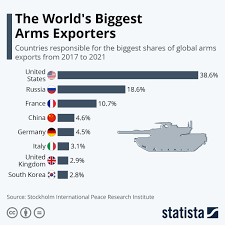
https://www.oxfam.org/en/press-releases/top-five-arms-exporters-hit-year...
As world leaders meet this week to discuss Protection of Civilians at the UN Security Council, Oxfam calls on them to invest in saving lives instead of promoting wars.
The world spent yearly an estimated $112 billion on arms imports between 2018-2022, even as 9,000 people die each day from hunger driven primarily by conflict. The top five-arms exporters – the USA, Russia, France, China and Germany - which account for over three-quarters of the global arms trade, together sold an estimated $85 billion worth of arms yearly.
“For four of the five permanent members of the Security Council to top global arms sales that fuel wars around the globe is hypocritical, complicit and immoral."
“For four of the five permanent members of the Security Council to top global arms sales that fuel wars around the globe is hypocritical, complicit and immoral. Their guns and bombs are not only killing innocent civilians in conflict-torn countries, but starving those who survive," said Brenda Mofya, Oxfam’s Head of New York office.
Global exports of major conventional weapons in 2018-2022 were 4.8% higher than a decade earlier, while over the same period nearly 48,000 civilians were killed in conflicts and wars that also displaced nearly 90 million from their homes.
“This is just the tip of the iceberg. Warlords and mercenaries are also reaping billions in profit from illegal and off-the-book trafficking of small arms and light weapons that fuel conflict in countries like Somalia and South Sudan,” Mofya said.
Across the world, ongoing conflict has been the primary driver in pushing 117 million people in 19 countries to extreme hunger last year alone.
Millions of poor people have been “triple hit” not only by conflict, but also by climate breakdown and economic shocks which are exhausting their abilities to cope and survive.
“This is just the tip of the iceberg. Warlords and mercenaries are also reaping billions in profit from illegal and off-the-book trafficking of small arms and light weapons that fuel conflict in countries like Somalia and South Sudan.”
Global military spending reached a record $2.2 trillion in 2022, enough to cover the year’s UN global humanitarian appeal ($51.7bn) more than 42 times. In Sub-Saharan Africa, governments spent $19 billion on the military. Meanwhile, African governments spent less on agriculture than they did two decades ago.
In countries ravaged by conflict like South Sudan, military spending rose by more than 50% last year, even while 7.7 million people (63% of the population) faced extreme hunger.
Many South Sudanese are resorting to extreme coping mechanisms like child marriage or taking their child out of school to survive. Conflict also directly hampers people’s access to humanitarian aid, with food being weaponized for political gains.
“As world leaders meet this week to discuss Protection of Civilians at the UN Security Council, they must prioritize peace over profit, and food over firearms. Warring parties must also not weaponize food, and allow aid to reach those who urgently need it,” added Mofya.
Notes to editors
The UN week on Protection of Civilians takes place 22-25 May 2023, and the Open debate will be aired live on UN TV.
SIPRI estimates that annual arms exports total $112bn, based on 2019-2020 data, and notes that the figure is likely higher. See SIPRI databaseSIPRI database
Data on crisis-level hunger (Integrated Food Security Phase Classification System Phase 3 or higher, IPC 3+) driven by conflict are taken from the Global Report on Food Crises 2023
We calculate daily deaths attributable to IPC 3 level hunger driven by conflict using the IPC Technical Manual Version 3.1. Because figures are not disaggregated into IPC 3, 4 and 5, the estimate is conservative. For IPC 3, crude daily death rates are 0.5-0.99 per 10,000, and we subtract 0.22 from each end of the range to account for “normal deaths” based on World Bank data . Thus, the daily deaths attributable to IPC 3 acute food insecurity for the 117 million affected people in 19 countries where conflict is the main driver of hunger (according to the GRFC 2023) would be 3,276-9,009.
Data on exports of major conventional arms are from “Trends in International Arms Transfers, 2022,” Stockholm International Peace Research Institute (SIPRI) Factsheet.
Data on illicit and off-book sales of small arms and light weapons are from the SIPRI report, Illicit Small Arms and Light Weapons in Sub-Saharan Africa.
Data on global military spending is from the SIPRI Military Expenditure Database
Data on government spending on agriculture from the Food and Agriculture Organization of the United Nations (FAO)
The total UN appeal for 2022 was $51.7 billion; see UN Office for the Coordination of Humanitarian Affairs (OCHA) Financial Track Service Database; see UN Office for the Coordination of Humanitarian Affairs (OCHA) Financial Track Service Database, Global military spending of $2.2 trillion which is more than 42 times greater the UN appeal.
UNHCR Global Trends report (published June 2022): "89.3 million individuals worldwide were forcibly displaced as a result of persecution, conflict, violence, human rights violations or events seriously disturbing public order."
According to Global Disorder in 2022, published by the Armed Conflict Location & Event Data Project (ACLED), acts targeting civilians in conflict situations led to over 47,700 civilian deaths in 2022.
Contact information
Lauren Hartnett in the US | Humanitarian Media Lead | lauren.hartnett@oxfam.org | +1 203 2473920
Nesrine Aly in the UK | Global News Manager | nesrine.aly@oxfam.org | +447503989838
For updates, please follow @NewsFromOxfam and @Oxfam










Add new comment